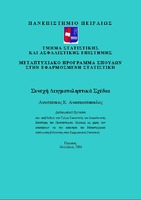Συνεχή δειγματοληπτικά σχέδια

Master Thesis
Author
Αναστασόπουλος, Αναστάσιος Κ.
Date
2007-05-25View/
Subject
Διατριβές ; Sampling (Statistics)Abstract
Ever since the Dodge and Roming’s inspection tables were published (1914)
on behalf of American army at the duration of World War II, the acceptance sampling
is continuously being developed and is being propagated widely in the global industry. The aim that acceptance sampling is used varies in proportion to the circumstances and is being shaped depending on the requirements of the producer and consumer. For a producer, for example, the acceptance sampling is used in order (a) to satisfy some standard requirements, such as those set by the British Standards Institution (b) to grade the lots for sale, (c) to prevent bad lots being passed on to consumers, or to the next production and (d) to reduce costs. For a consumer, the aims might be (a) to confirm the that the quality of goods supplied is up to standard, (b) to prevent bad lots being passed on to a production process, (c) to grade lots for different uses, for different prices and (d) to encourage the producer to provide the quality desired. Different aims required different schemes for choosing the sampling plan. As
in many practical situations the aim of inspection is not easy to define precisely and
the information available is limited, the design of a suitable sampling plan is often a
complicated problem. Sampling inspection procedures can have various forms: simple
sampling, double sampling multiple sampling, sequential sampling, continuous sampling, and so on, each having its particular advantages and disadvantages. The simple sampling plan is the most commonly used from the above, because of its simplicity and extensive research has been carried out for its aspects. In the present work we are going to deal more with the sampling plans for continuous production.


